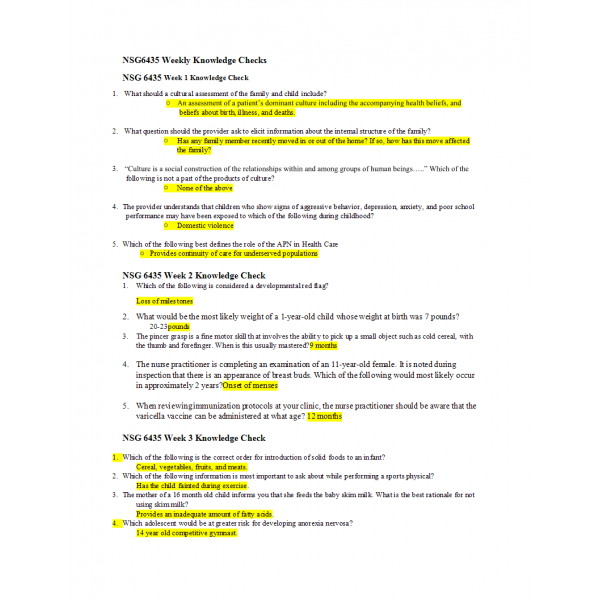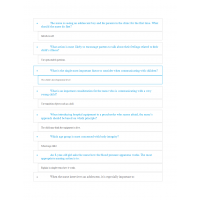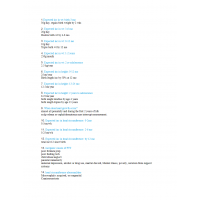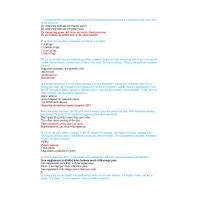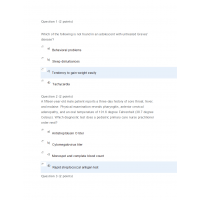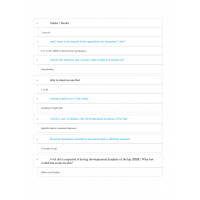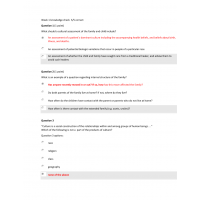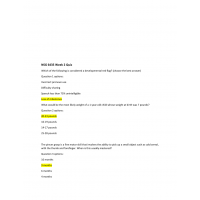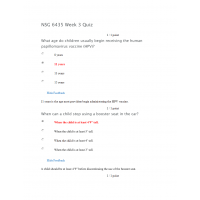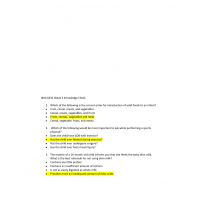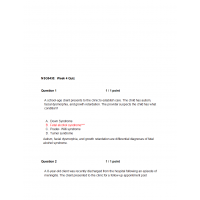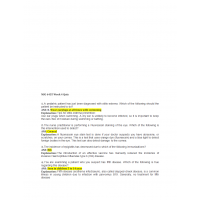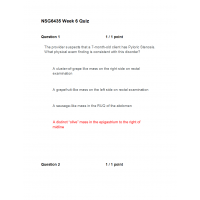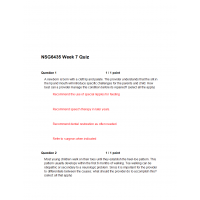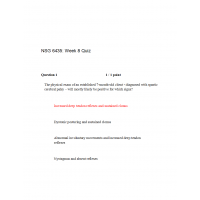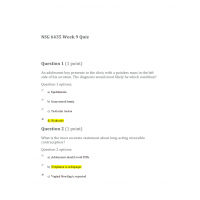NSG 6435 Week 1 to 10 Quiz
NSG6435 Weekly Knowledge Checks
NSG 6435 Week 1 Knowledge Check
1. What should a cultural assessment of the family and child include?
2. What question should the provider ask to elicit information about the internal structure of the family?
3. “Culture is a social construction of the relationships within and among groups of human beings…..” Which of the following is not a part of the products of culture?
4. The provider understands that children who show signs of aggressive behavior, depression, anxiety, and poor school performance may have been exposed to which of the following during childhood?
5. Which of the following best defines the role of the APN in Health Care
NSG 6435 Week 2 Knowledge Check
1. Which of the following is considered a developmental red flag?
2. What would be the most likely weight of a 1-year-old child whose weight at birth was 7 pounds?
3. The pincer grasp is a fine motor skill that involves the ability to pick up a small object such as cold cereal, with the thumb and forefinger. When is this usually mastered?
4. The nurse practitioner is completing an examination of an 11-year-old female. It is noted during inspection that there is an appearance of breast buds. Which of the following would most likely occur in approximately 2 years?
5. When reviewing immunization protocols at your clinic, the nurse practitioner should be aware that the varicella vaccine can be administered at what age?
NSG 6435 Week 3 Knowledge Check
1. Which of the following is the correct order for introduction of solid foods to an infant?
2. Which of the following information is most important to ask about while performing a sports physical?
3. The mother of a 16 month old child informs you that she feeds the baby skim milk. What is the best rationale for not using skim milk?
4. Which adolescent would be at greater risk for developing anorexia nervosa?
5. The NP is reviewing strategies to increase physical activity. The patient should also be educated that which of the following are commonly associated with sports injuries?
NSG 6435 Week 4 Knowledge Check
1. A pediatric patient has just been diagnosed with otitis externa. Which of the following should the patient be instructed to do?
2. The NP is performing a Fluorescein staining of the eye. Which of the following is this intervention used to
3. The incidence of epiglottitis has decreased due to which of the following immunizations?
4. You are examining a patient who you suspect has 5th disease. Which of the following is true regarding this disease?
5. Which specific viral organism causes hand, foot, and mouth syndrome?
NSG 6435 Week 5 Knowledge Check
1. A NP is completing a cardiac assessment on a child and detects a murmur. Which of the following is true regarding innocent murmur?
2. A child presents to the primary care clinic with chest pain. The provider is aware that chest pain in children is usually a symptom of?
3. Which of the following is a common cause of acquired coronary artery disease during childhood?
4. What type of hemorrhage would be expected with severe factor VIII deficiency?
5. The NP suspects that a pediatric patient is exhibiting the signs and symptoms consistent with Leukemia. To confirm this diagnosis, which test/procedure should be ordered?
NSG 6435 Week 6 Knowledge Check
1. Vomiting in infancy has a long list of differential diagnoses. Which accompanying symptom would most likely indicate pyloric stenosis?
2. Which of the following findings could be expected to occur in a baby with intussusception?
3. A pediatric patient presents with symptoms consistent with the early phase of appendicitis. Which of the following would be the most likely presentation?
4. The NP is completing education with parents of a child with celiac disease. Which of the following foods would be most appropriate?
5. A male patient presents with symptoms consistent for testicular torsion. What would be the first priority for this patient?
NSG 6435 Week 7 knowledge Check
1. A 5 year old boy presents to the clinic with his mother who states the chief complaint of “painful limping on the right leg for 2 days.” Today he has a low grade fever. Which of the following would be the most likely diagnosis?
2. Which of the following is a typical presentation of a dislocated hip of a child 6 months or older?
3. During the examination of a 3-week old, it is noted that the infant is irritable when lifted, has asymmetrical moro reflex, and spasms along the right sternocleidomastoid. What does this suggest?
4. A newborn has a vascular lesion that will not fade as the child gets older. What is your diagnosis?
5. A 13 year old presents with several vesicles and honey colored crusted lesions on the face. The initial injury was a scratch. What would be the most likely diagnosis?
NSG 6435 Week 8 Knowledge Check
1. The parents of an established patient call the pediatric clinic to ask what they should do for their child who tripped, fell, and hit their head on the sidewalk. Which of the following symptoms would require that the child goes to the ER?
2. Which of the following is the best measure of childhood intelligence?
3. A NP has a follow-up visit with a child who experienced a febrile seizure. Which of the following statements would be the most accurate when educating the parents on febrile seizures?
4. A child with Tourette Syndrome presents to the pediatric clinic. Which of the following should the NP be aware of?
5. A child who is enrolled in Head Start is suspected of having developmental delays based on Denver II results at two separate clinic visits. What would be the next step in the plan of care?
NSG 6435 Week 9 Knowledge Check
1. The signs and symptoms of bacterial sepsis in children beyond the neonatal period has a common presentation. Which of the following would be the most typical?
2. A 11 year old child presents with fever, sore throat, and swollen lymph nodes. The abdominal exam reveals a spleen tip that is palpable. A throat culture and Monospot test results are negative. What would be the next step in the plan of care:
3. The NP has a differential diagnosis of Lyme disease. Which of the following skin lesions would confirm the diagnosis?
4. Which of the following would best reflect the physical presentation in a newborn with Down’s Syndrome?
5. What is an expected finding in young infants with cerebral palsy (CP)?
NSG 6435 Week 10 Knowledge Check
1. An adolescent boy presents to the clinic with a painless mass in the left side of his scrotum. The diagnosis would most likely be which condition?
2. What is the most accurate statement about long-acting reversible contraception?
3. Which of the following is a risk factor for pregnancy?
4. An exam reveals foul-smelling vaginal discharge that emits a fishy odor when combined with 10% potassium hydroxide. What would be the diagnosis?
5. Which of the following is an absolute contraindication for the use of combined hormonal contraceptives in adolescent women?
| Institution & Term/Date | |
| Term/Date | South University |
-
$25.00

